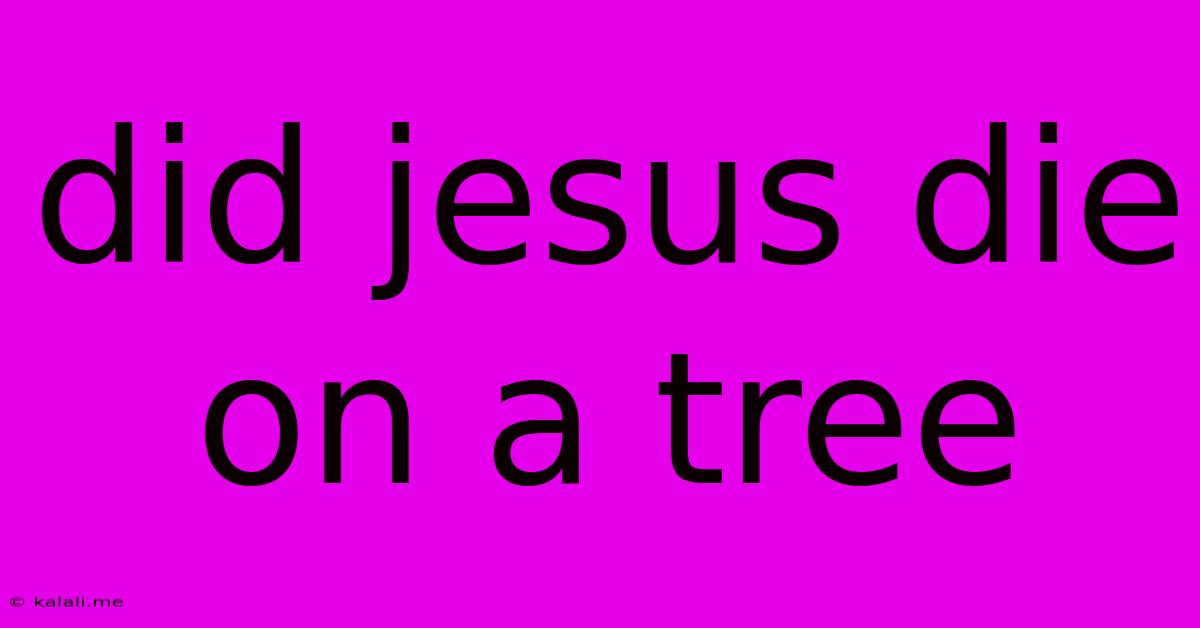Did Jesus Die On A Tree
Kalali
Jun 03, 2025 · 3 min read

Table of Contents
Did Jesus Die on a Tree? Examining the Biblical Accounts
The question of whether Jesus died on a tree is a nuanced one, stemming from the differing translations and interpretations of the original Greek texts of the New Testament. While popular imagery often depicts a cross, the precise nature of the execution instrument used is a subject of ongoing theological and historical debate. This article explores the biblical accounts and their interpretations to provide a comprehensive understanding of this complex issue.
The common understanding, reinforced by centuries of Christian art and tradition, is that Jesus was crucified on a cross – a specifically shaped wooden instrument. However, the Greek word used in the Gospels, stauros, doesn't explicitly define the shape. This ambiguity opens the door to different interpretations, influencing how we understand the event and its symbolic meaning.
The Greek Word Stauros and its Interpretations
The word stauros in classical Greek referred to an upright stake or pole, not necessarily the familiar two-beam cross. Some scholars argue that the Roman practice of crucifixion involved a simple wooden post, while others maintain that stauros could encompass a variety of forms, including the more elaborate cross shape. The lack of explicit description in the Gospels leaves room for differing scholarly opinions. The crucial point is that the method of execution, whether on a simple stake or a cross, resulted in a brutal and agonizing death.
The Significance of the Execution Instrument
Regardless of the precise shape of the execution instrument, its symbolic significance remains profound within Christianity. The crucifixion is understood as a sacrificial act, where Jesus's death atones for the sins of humanity. This central tenet of Christian belief transcends the specific details of the instrument used. The emphasis lies on the suffering, sacrifice, and resurrection of Jesus, rather than the precise shape of the wood.
Historical and Archaeological Evidence
While archaeological evidence directly related to Jesus' crucifixion is scarce, studies of Roman crucifixion practices provide some context. These studies indicate that a variety of execution methods were employed, ranging from simple stakes to more elaborate crosses. This historical evidence supports the possibility that stauros could have been a less elaborate structure than traditionally depicted.
Theological Interpretations
Theological interpretations of the crucifixion often focus on its symbolic meaning, rather than the literal shape of the instrument. The image of the cross has become a powerful symbol of faith, hope, and redemption, representing Christ's sacrifice and the promise of salvation. Even if the exact form of the stauros remains uncertain, its spiritual significance remains central to Christian belief.
Conclusion: The Focus Shifts Beyond the Instrument
Ultimately, the question of whether Jesus died on a tree or a cross is less important than the theological message conveyed. The accounts in the Gospels emphasize Jesus's suffering, death, and resurrection as the foundation of Christian faith. While the exact form of the stauros remains open to interpretation, its role in the narrative of salvation remains paramount. The focus should remain on the profound spiritual significance of the event itself, rather than getting bogged down in the specifics of the execution instrument. The core message of redemption and sacrifice transcends the details of the wooden structure.
Latest Posts
Latest Posts
-
Another Way Of Saying Nobody Asked
Jun 05, 2025
-
Can I Use 205 55r16 Instead Of 205 60r16
Jun 05, 2025
-
Signs Elhokar Was Going To Be A Lightweaver
Jun 05, 2025
-
Do I Need To Change Oil Filter Every Time
Jun 05, 2025
-
How To Say His In Spanish
Jun 05, 2025
Related Post
Thank you for visiting our website which covers about Did Jesus Die On A Tree . We hope the information provided has been useful to you. Feel free to contact us if you have any questions or need further assistance. See you next time and don't miss to bookmark.